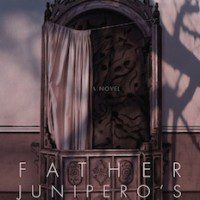When Josiah Royce wrote his book California: A Study of American Character in the 1880s, he noted in the preface that his history would begin with the “American California” that emerged from the Mexican-American War. Still, the famed philosopher, himself the son of parents who migrated to California during the Gold Rush, made a point of giving some context to the reader unfamiliar with the Golden State and its Hispanic past. Paramount in his brief section “Outlines of Older California History” is a page on the Franciscan missions—a chain of missionary communities that ultimately stretched from San Diego to Sonoma, and of which Royce wrote, “the chief significance of the missions is simply that they first began the colonization of California”. The incendiary force behind this colonization was, of course, “the famous head of the missionaries, Father Junípero Serra”.
“The personal enthusiasm of Father Junípero”, Royce added, “who from 1769 until his death in 1784 was at the head of mission affairs, has earned for him since a great popular reputation for ability and saintliness, a reputation made permanent by the biography that came from the pen of his friend Palóu. And about Serra’s high worth as a man and a Christian there is indeed no controversy among those who know his career.” Controversy there may be in the 130 years since Royce wrote those words—due in no small part to Serra’s aggressive efforts to convert the Native Californians to Catholicism—but even today, Serra looms large in the popular imagination of California history. His is one of the two statues California sent to Washington, D.C., to represent the state in the National Statuary Hall on Capitol Hill (the other is of Ronald Reagan), and his name can still be found on schools and street signs, his statue in parks and in front of the very missions he built.
Nick Taylor’s new novel, Father Junípero’s Confessor, depicts convincingly the sheer willpower, the superior intellect, and the overbearing and manipulative personality of this missionary from Majorca. Told from the viewpoint of Fray Francisco Palóu, the Franciscan whose biography of Serra Royce cites, the novel is at first glance a story about the rivalry for Serra’s favor between Palóu and Fray Juan Crespí, the two missionaries who accompanied Serra from their island home to the New World. Hewing closely to the historical record, Crespí appears to be the victor of this internecine struggle: he is the one chosen to accompany Serra on the Spanish expeditions to Alta California, while Palóu is left to oversee the missions in Baja California. Crespí’s letters and journals—which are still read today—report in detail Portolá’s expedition to find Monterey Bay, including the expedition’s accidental discovery of San Francisco Bay; while reading Crespí’s reports, Palóu stews in bitterness at being left behind, so far from both Serra and the opportunity to serve the Lord in the far reaches of the Spanish empire.

As the novel unfolds, however, it becomes clear that this is not really a novel about Palóu and Crespí after all. This is a novel about Serra and his nearly maniacal resolve to conquer California in the name of Christianity. Though he goes to great lengths to demonstrate his fealty to God, Serra, with his ambition and tendency toward sadistic exhibitionism, consistently violates the tenets of the Christian faith. Taylor’s Serra is not one for the faint of heart. From brutal self-flagellations to a violent re-enactment of the Stations of the Cross—a scene that leaps off the page in Taylor’s clean prose—Junípero Serra in this novel is more cult leader than beatified friar. As a character of fiction, he is fascinating.
Father Junípero’s Confessor is at its best when describing Serra and his machinations, but Taylor’s ability to write beautiful, engaging passages also deserves praise. After Palóu is finally summoned to Alta California by Serra, the time he spends at the Carmel mission elicits some of the best prose in the novel. Taylor depicts the tension between the presidio at Monterey and the mission community Palóu struggles to foster, as well as the activities and inhabitants of the Native Californian settlements in Carmel Valley, with equal skill. And although this is historical fiction, and thus the events and their outcomes are generally known, Taylor generates considerable momentum throughout the novel with unanswered questions and a few surprising narrative twists. What, exactly, does Serra really think? And just how trustworthy is Palóu?
The novel does occasionally falter. As opposed to the complex central characters, a couple of the peripheral ones are more like caricatures than fully fleshed out individuals; this is particularly true of a Native Californian whom Palóu mentors, and a Spanish governor whom Palóu accompanies to San Francisco Bay. A few scenes read like transitional filler, though they are still entertaining. And perhaps the most confusing element of the novel is the way in which it relays time. It is frequently difficult to tell how far back in the past or into the future an event takes place, particularly after the missionaries depart Spain.
“I made the sign of the cross and bowed my head—one last private moment with my master”, Palóu tells us at the end of the novel. “Then I threw open the door and shared him with the world”. It is Palóu we must thank for sharing Serra with the world, for he is the one who wrote the hagiography that helped turn the missionary from Majorca into el Apóstol de California—the epitaph that still graces Serra’s grave at the mission in Carmel. But we must also thank Taylor and other great writers of historical fiction. Father Junípero’s Confessor is an engaging exploration—not of who el Apóstol was, but of who he might have been.





One response
Sigh. Yet another attempt to portray the reverend father as some kind of fanatic who only cared about placing the poor natives under the cruel yolk of Catholicism.
Of course, it is truly difficult to provide a full review without reading the “novel” which is another term for one writer’s viewpoint of historical fact. But, reading this leads me to believe that the portrayal leans toward the sensational – and is therefor biased.
Click here to subscribe today and leave your comment.